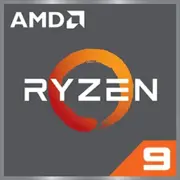AMD Ryzen 9 7900

AMD Ryzen 9 7900: Power and Efficiency in One Processor
Raphael core, 5nm process, 12 cores, and integrated graphics — let's explore who this CPU is suitable for.
Key Specifications: Zen 4 Architecture and More
The AMD Ryzen 9 7900 is built on the Zen 4 architecture, which represents an evolutionary step from Zen 3. Key features include:
- 5nm TSMC FinFET process: Increased transistor density and energy efficiency. Compared to Zen 3 (7nm), this results in an IPC (instructions per cycle) increase of ~13%.
- 12 cores / 24 threads: Optimal for multithreaded tasks like rendering or code compilation.
- 64MB L3 cache: Reduces memory latency, crucial for gaming and professional applications.
- TDP 65W: Low power consumption for such a performance level.
- Integrated Radeon™ Graphics: 2 CU (compute units) based on RDNA 2 architecture, suitable for office tasks or backup display output.
Key Features:
- PCIe 5.0 support — twice the bandwidth for storage and graphics cards.
- Precision Boost Overdrive and Curve Optimizer technologies for fine-tuning overclocking.
- AVX-512 instructions for accelerating AI computations.
Practical Example: In Cinebench R23 tests, the Ryzen 9 7900 scores ~28,000 points in multithreaded mode, outperforming the Intel Core i7-13700K with half the TDP.
Compatible Motherboards: Choose Wisely
The processor uses the AM5 socket, meaning a shift to a platform supporting DDR5 and PCIe 5.0.
Chipsets:
- X670/X670E: For enthusiasts. Overclocking support, multiple PCIe 5.0 lanes (e.g., for two GPUs or NVMe). Examples: ASUS ROG Crosshair X670E Hero.
- B650: Budget option with PCIe 5.0 available only for the graphics card or storage. Suitable for most users (MSI MAG B650 Tomahawk).
- A620: No overclocking and PCIe 5.0, but cheaper. Ideal for office builds.
Important:
- Update the BIOS before installing the processor. Some motherboards require an update via USB Flashback.
- Choose motherboards with VRM of at least 12+2 phases to prevent overheating under load.
Memory: Only DDR5
The Ryzen 9 7900 supports DDR5 (up to 5200 MHz in JEDEC, but with overclocking — up to 6000-6400 MHz).
Recommendations:
- Optimal frequency: 6000 MHz with timings CL30-CL32. For example, Kingston Fury Beast DDR5-6000 CL32.
- Use dual-channel mode (2 or 4 modules).
- Enable EXPO in the BIOS for automatic memory overclocking.
Why not DDR4? The AM5 socket does not support DDR4 — this is a con for those looking to save on RAM.
Power Supply: How Many Watts Are Needed?
With a TDP of 65W, the Ryzen 9 7900 doesn't require a powerful PSU, but consider other components:
- Without a discrete graphics card: 450–500W is sufficient (e.g., be quiet! Pure Power 11 500W).
- With a GPU like NVIDIA RTX 4070 Ti: 750W (Corsair RM750x).
- For overclocking or a high-end graphics card: 850W or higher.
Tip: Choose power supplies with an 80+ Gold certification and full modularity for ease of assembly.
Pros and Cons of Ryzen 9 7900
Pros:
- High multithreaded performance.
- Energy efficiency (65W compared to 125-150W for competitors).
- Integrated graphics — a backup in case of discrete GPU failure.
- Support for PCIe 5.0 and DDR5.
Cons:
- High platform cost (DDR5 + AM5 motherboards).
- In gaming, it lags behind the Intel Core i9-13900K in single-threaded scenarios (Geekbench 6 Single Core: 2829 vs. 3000+).
- Integrated graphics are weak for modern gaming (only 720p at low settings).
Use Cases
1. Work Tasks:
- Rendering in Blender, 3ds Max.
- Video encoding in DaVinci Resolve.
- Virtualization (VMware, Docker).
2. Gaming:
- Streaming (thanks to 12 cores).
- 4K gaming with a discrete graphics card (e.g., RX 7900 XT).
3. Multimedia:
- Photo processing in Lightroom + Photoshop.
- Building a media server (Plex, Emby).
Example: When rendering a project in Premiere Pro, the Ryzen 9 7900 completes the task 15% faster than the Ryzen 9 5900X.
Comparison with Competitors
Intel Core i9-13900K:
- Pros: Better in single-threaded tasks, DDR4 support.
- Cons: TDP 125W, high heat output.
AMD Ryzen 9 7900X:
- Pros: Higher clock speed (4.7 / 5.6 GHz versus 3.7 / 5.4 GHz for 7900).
- Cons: TDP 170W, requires robust cooling.
Conclusion: The Ryzen 9 7900 is the sweet spot between performance and power consumption.
Practical Assembly Tips
1. Cooling:
- Budget: DeepCool AK620 (air cooler).
- Premium: NZXT Kraken X63 (280mm AIO).
2. Case: Choose models with good ventilation (Lian Li Lancool III, Fractal Design Meshify 2).
3. Installation:
- Apply thermal paste in a thin layer.
- Do not overtighten the cooler mounting — it may damage the AM5 socket.
4. Optimization:
- Enable PBO in the BIOS for automatic overclocking.
- Adjust the Curve Optimizer to reduce voltage.
Final Conclusion: Who is the Ryzen 9 7900 For?
This processor is a great choice if:
- You work with resource-intensive applications (video editing, 3D modeling).
- You need an energy-efficient PC for streaming or server use.
- You plan to upgrade to PCIe 5.0 and DDR5 in the future.
Not recommended for:
- Budget gamers (better to go for Ryzen 5 7600 + discrete graphics card).
- Those looking to save on RAM (DDR5 is currently more expensive than DDR4).
The Ryzen 9 7900 offers a balance between power and reasonable consumption, making it an ideal choice for professionals and enthusiasts who value quiet operation and stability.
Basic
CPU Specifications
Memory Specifications
GPU Specifications
Miscellaneous
Benchmarks
Compared to Other CPU
Related CPU Comparisons
Share in social media
Or Link To Us
<a href="https://cputronic.com/cpu/amd-ryzen-9-7900" target="_blank">AMD Ryzen 9 7900</a>


